Difference between revisions of "Modules:IA FEMesh-Documentation-3.4"
(New page: Return to Slicer 3.4 Documentation __NOTOC__ ===Module Name=== IA_FEMesh (A Finite Element Meshing Module from the University of Iowa) {| |[[Image:screenshotBlank.p...) |
|||
| Line 11: | Line 11: | ||
== General Information == | == General Information == | ||
| − | + | A loadable module that automates creation of surface and volumetric meshes for finite element analysis. | |
===Module Type & Category=== | ===Module Type & Category=== | ||
| Line 20: | Line 20: | ||
===Authors, Collaborators & Contact=== | ===Authors, Collaborators & Contact=== | ||
| − | * Nicole Grosland, University of Iowa | + | * Nicole Grosland, University of Iowa, grosland@engineering.uiowa.edu |
| − | * Vince Magnotta, University of Iowa | + | * Vince Magnotta, University of Iowa, vincent-magnotta@uiowa.edu |
| − | * Kiran | + | * Kiran Shivanna, University of Iowa, kshivann@engineering.uiowa.edu |
| − | * | + | * Curtis Lisle, KnowledgeVis, clisle@knowledgevis.com |
| + | * Steve Pieper, Isomics, pieper@bwh.harvard.edu | ||
===Module Description=== | ===Module Description=== | ||
| − | + | This module allows the creation and editing of surface and volumetric meshes. Polygonal surfaces in VTK or STL format are imported to begin the process. Then a unique and intuitive bounding surface (called Building Blocks) are created interactively by the user and used to guide automated meshing algorithms. The module includes visualization and analysis reports of the quality of mesh elements. Meshes can be written out in Abaqus of VTK format for later processing. | |
== Usage == | == Usage == | ||
Revision as of 14:20, 3 February 2009
Home < Modules:IA FEMesh-Documentation-3.4Return to Slicer 3.4 Documentation
Module Name
IA_FEMesh (A Finite Element Meshing Module from the University of Iowa)
General Information
A loadable module that automates creation of surface and volumetric meshes for finite element analysis.
Module Type & Category
Type: Interactive
Category: Meshing
Authors, Collaborators & Contact
- Nicole Grosland, University of Iowa, grosland@engineering.uiowa.edu
- Vince Magnotta, University of Iowa, vincent-magnotta@uiowa.edu
- Kiran Shivanna, University of Iowa, kshivann@engineering.uiowa.edu
- Curtis Lisle, KnowledgeVis, clisle@knowledgevis.com
- Steve Pieper, Isomics, pieper@bwh.harvard.edu
Module Description
This module allows the creation and editing of surface and volumetric meshes. Polygonal surfaces in VTK or STL format are imported to begin the process. Then a unique and intuitive bounding surface (called Building Blocks) are created interactively by the user and used to guide automated meshing algorithms. The module includes visualization and analysis reports of the quality of mesh elements. Meshes can be written out in Abaqus of VTK format for later processing.
Usage
Examples, Use Cases & Tutorials
- Note use cases for which this module is especially appropriate, and/or link to examples.
- Link to examples of the module's use
- Link to any existing tutorials
Quick Tour of Features and Use
List all the panels in your interface, their features, what they mean, and how to use them. For instance:
- Input panel:
- Parameters panel:
- Output panel:
- Viewing panel:
Development
Dependencies
Other modules or packages that are required for this module's use.
Known bugs
Follow this link to the Slicer3 bug tracker.
Usability issues
Follow this link to the Slicer3 bug tracker. Please select the usability issue category when browsing or contributing.
Source code & documentation
Customize following links for your module.
Links to documentation generated by doxygen.
More Information
Acknowledgment
Include funding and other support here.
References
Publications related to this module go here. Links to pdfs would be useful.
